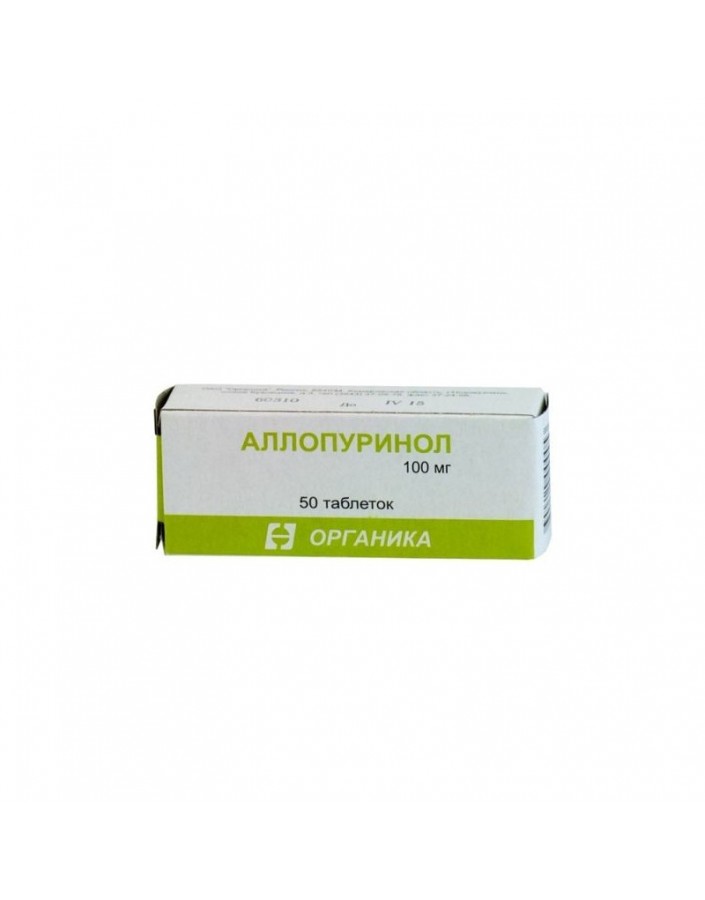




Security policy (edit with Customer reassurance module)

Delivery policy (edit with Customer reassurance module)

Return policy (edit with Customer reassurance module)
Pills Allopurinol round, white or grayish-white, with two flat sides, on one side - risk, on the other - engraving E351 (tab. 100 mg) or E352 (tab. 300 mg), odorless;
1 pill contains Allopurinol -100 or 300 mg;
30 pieces - in bottles of dark glass 50 or 30 pieces, in a carton box - 1 bottle.
Anti-gout, hypouricemic.
Allopurinol inhibits xanthine oxidase, interferes with the conversion of hypoxanthine into xanthine and xanthine into uric acid, thus limiting the synthesis of uric acid. Lowers the content of urate in the serum, prevents their deposition in the tissues and kidneys.
Gout, primary hyperuricemia, primary uric nephropathy with or without signs of gout (prophylaxis or treatment), secondary hyperuricemia in blood diseases due to increased cell breakdown during radio and / or Chemotherapy of leukemia, lymphoma and other malignant diseases (prevention and treatment); urolithiasis and the formation of calcium-oxalate stones in hyperuricuricuria (prevention and treatment).
Hypersensitivity, marked impaired liver and kidney function (azotemia), idiopathic hemochromatosis (includingfamily history), asymptomatic hyperuricemia, acute attack of gout, pregnancy, breast-feeding. At the time of treatment, Allopurinol should stop breastfeeding.
Allopurinol is taken orally after meals. Begin with 100 mg / day, once, then gradually increase the dose. If, at a dose of 300 mg per day, side effects from the gastrointestinal tract occur, fractional administration is possible.
Adults: 100-200mg per day, with a state of moderate severity, 300-600mg per day, in severe condition -700-900mg per day.
Children: up to 15 years -10-20mg / kg per day (up to 400mg per day maximum)
With severe renal failure, 100mg per day or 100mg with an interval of more than 1 day. Elderly patients are recommended the lowest doses of allopurinol.
From the nervous system and sensory organs: neuritis, sleep disorders, depression, amnesia, cataracts, conjunctivitis, amblyopia.
Since the cardiovascular system and blood (hematopoiesis, hemostasis): rarely - vasculitis, pericarditis, bradycardia, thrombophlebitis, thrombocytopenia, eosinophilia, leukopenia, leukocytosis, aplastic and hemolytic anemia, reticulocytosis, lymphocytosis.
On the part of the digestive tract: nausea, vomiting, abdominal pain, diarrhea, rarely - granulomatous hepatitis, increased activity of hepatic transaminases and alkaline phosphatase.
From the genitourinary system: rarely, interstitial nephritis, hematuria, proteinuria, peripheral edema.
Allergic reactions: rash, fever, rarely - bronchospasm.
Other: possible for diseases of the liver or kidneys - itching, maculopapular lesions, purpura; in very rare cases, an exfoliative skin reaction accompanied by fever, lymphadenopathy, arthralgia and eosinophilia, similar to Stevens-Johnson syndrome and / or Lyell (require discontinuation of the drug and treatment with corticosteroids).
Allopurinol
Symptoms: nausea, vomiting, diarrhea (weakened with abundant fluid intake and a corresponding increase in diuresis).
Treatment: dialysis.
At the beginning of treatment for 1 month, NSAIDs or colchicine should be prescribed simultaneously to prevent an acute attack of gout. Patients with renal or hepatic insufficiency and advanced age should reduce the dose of allopurinol due to an increased risk of intoxication.
List B. At a temperature of 15–25 ° C.
Allopurinol